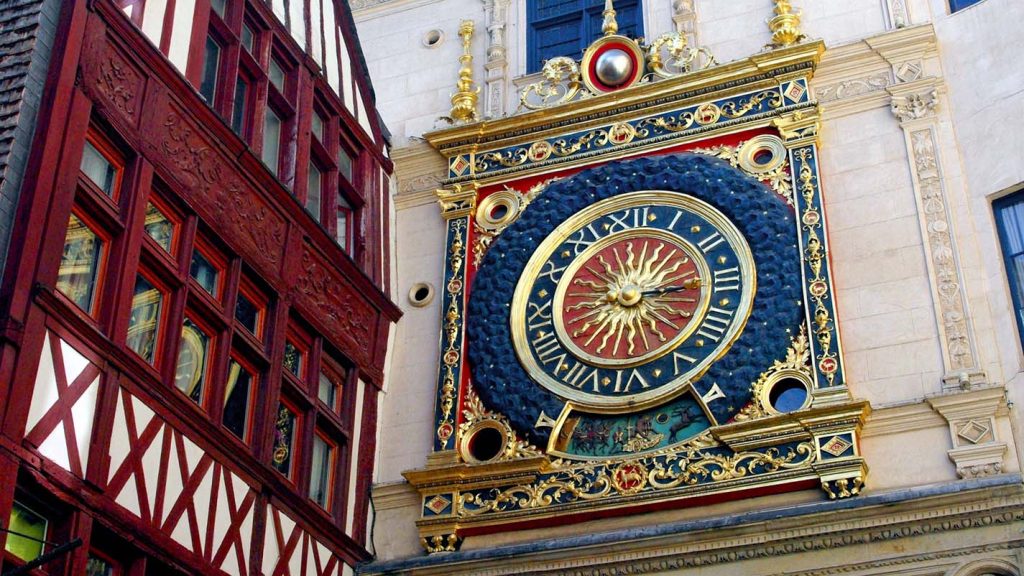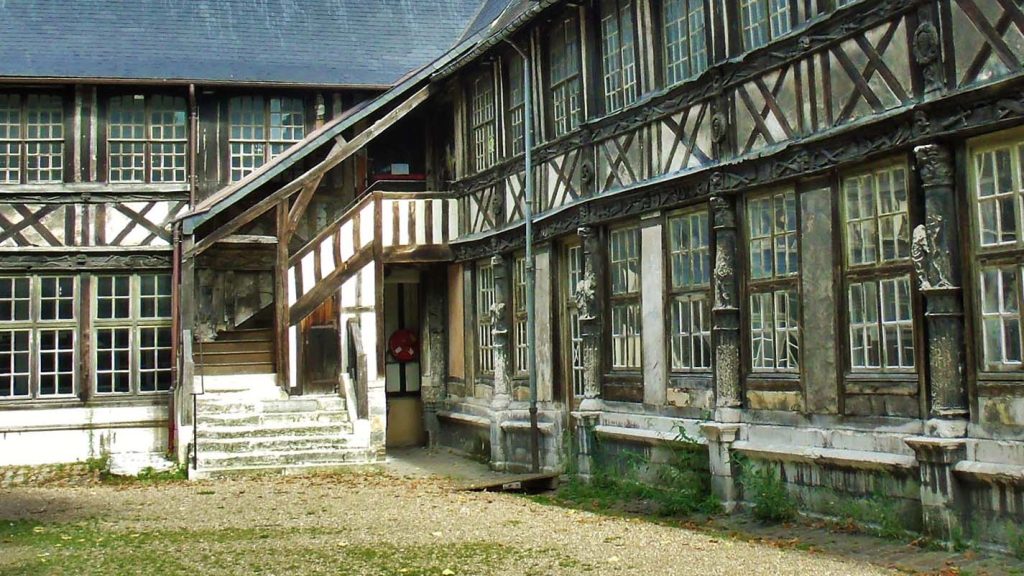In the heart of Normandy, Rouen beckoned me with its cobblestone streets and half-timbered houses, promising a journey through history and culinary delights.I couldn’t resist the allure of a destination that whispered tales of centuries past from every corner.
Captivated by Rouen’s Old Quarter: A Journey Through Time
As I wandered through the enchanting old town of Rouen, I couldn’t help but feel like a time traveler, embarking on a captivating journey through the annals of history. The crooked half-timbered houses seemed to lean in, eager to share their secrets, and each twist and turn of the cobblestone streets revealed a new chapter in Rouen’s storied past.
A Tale Told in Time: The Gros-Horloge

Rouen’s ancient streets held many treasures, but none quite as mesmerizing as the Gros-Horloge. Dating back to the 14th century, this astronomical clock wasn’t just a timekeeping device; it was a storyteller. With its intricate mechanisms and charming figurines, it transported me to medieval Rouen with every melodious chime. Standing before it, I felt like I had become a part of the city’s living history.
The Majestic Guardian: Rouen Cathedral
Rising above the city like a majestic guardian, the Rouen Cathedral is an architectural marvel that commands admiration. Immortalized by Claude Monet’s brushstrokes, this Gothic masterpiece dominates the skyline. Stepping inside, I was greeted by the ethereal beauty of stained glass windows that seemed to dance with light. They painted vibrant scenes that spoke of the dedication and artistry of the craftsmen who had created them centuries ago.
The Butter Tower’s Whimsical Legacy
Amidst all the grandeur, there was room for whimsy in Rouen’s history. I stumbled upon the Butter Tower, a charming part of the cathedral. Legend has it that the funds intended for its construction were diverted to purchase butter during Lent, hence the whimsical name. This delightful anecdote was a lighthearted reminder of history’s quirks and the unexpected twists that add character to a city’s story.
Practical Details: Navigating Rouen’s Old Quarter
- Gros-Horloge: Access to the Gros-Horloge is included in the Rouen Pass, which grants entry to several of the city’s attractions. Typically, the clock welcomes visitors from 10 AM to 6:30 PM.
- Rouen Cathedral: While entry is free, guided tours are available to provide deeper insights into the cathedral’s history. The cathedral generally opens its doors from 9:30 AM to 6:30 PM.
- The Butter Tower: This charming anecdote is a part of the Rouen Cathedral experience and can be explored as part of your visit to this iconic landmark.
Cooking Inspiration and Food
Exploring Rouen’s culinary scene was a journey of delight. At La Couronne, one of France’s oldest inns, I embarked on a culinary adventure. The Duck à l’Orange was a revelation—a harmonious blend of flavors that danced on my palate. Paired with a glass of local Calvados, it was a gastronomic symphony.
In Rouen, every meal was a story, from the warmth of apple tarts that felt like a hug to Camembert cheese that seemed to melt into my soul. Each dish was a love letter to Normandy’s culinary heritage.
Exploring Rouen’s Riverside Charm: A Tranquil Seine Sojourn
Having satisfied my palate with Rouen’s delectable cuisine, I decided to embark on a leisurely stroll along the picturesque banks of the Seine. The river, meandering gracefully through the heart of Rouen, provided a serene backdrop for my contemplative journey. Swans glided gracefully by, and the gentle breeze carried with it the whispers of a maritime history that had shaped this city.
As the sun began its descent, casting a warm, golden glow across the riverbanks, I found myself standing in the heart of Place du Vieux Marché. This bustling square, teeming with life and laughter, held a poignant historical significance—it was the very spot where Joan of Arc had met her tragic fate. The square’s vibrant present stood in stark contrast to its somber past, serving as a poignant reminder that history is a living, breathing entity.
My riverside escapade along the Seine had introduced me to a different facet of Rouen—a city that cherished both its history and the simple joys of life. It was a reminder that while the past may be written in stone, the present is where the heart of a city truly beats.
Aître Saint-Maclou: A Hidden Gem in Rouen’s Heart

Tucked away in the heart of the city, this unique cemetery is often overlooked by tourists, but for those who venture here, it offers a mesmerizing glimpse into the past.As I stepped through the unassuming entrance of Aître Saint-Maclou, I found myself transported to a different time.
The first sight that greeted me was a stunning courtyard, enclosed by timber-framed buildings that exuded an air of mystery. These buildings, adorned with intricate carvings, had once served as a plague cemetery, an ossuary, and a charnel house.
The courtyard itself was a work of art. The ground was paved with centuries-old tombstones, each bearing weathered inscriptions and symbols that hinted at the stories of those laid to rest beneath. The surrounding walls, adorned with detailed carvings, were a testament to the skill of craftsmen from long ago. The motifs ranged from macabre memento mori, reminding visitors of the inevitability of death, to intricate floral patterns and religious symbols.
One of the most captivating features of Aître Saint-Maclou was the timber-framed gallery that ran along one side of the courtyard. Walking beneath its arches, I felt as though I had stepped into a medieval painting. The wooden beams were adorned with sculpted skulls, bones, and other motifs associated with mortality. It was a stark reminder of the cemetery’s original purpose—to house the remains of those who had succumbed to the plague.
The charnel house, which once stored the bones of the deceased, has been transformed into an exhibition space. Here, visitors can learn about the history of Aître Saint-Maclou, the Black Death, and the art of ossuaries. The exhibition provides context to the site’s macabre beauty, shedding light on the somber history that permeates every corner.
What struck me most during my visit was the tranquility that enveloped Aître Saint-Maclou. Despite its eerie past, it has become a place of serenity and reflection. Visitors can sit on stone benches, surrounded by centuries of history, and contemplate the passage of time.
Aître Saint-Maclou is a place that invites you to explore its hidden corners and unravel its stories. It’s a testament to Rouen’s rich history and its ability to preserve the past for future generations. The fact that entry is free makes it a must-visit for anyone with an interest in history, architecture, or the quiet beauty of places where time stands still.
Practical Details: Visiting Aître Saint-Maclou
- Location: Aître Saint-Maclou is located in the heart of Rouen, near the Church of Saint-Maclou.
- Entry: The best part about Aître Saint-Maclou is that entry is completely free.
- Opening Hours: The site is generally open to visitors during standard daylight hours, but it’s a good idea to check ahead for any specific opening times or closures.
Musée des Beaux-Arts de Rouen: A Glimpse into Art’s Timeless Beauty
This museum, nestled within the heart of Rouen, promises to be a haven for those who appreciate the beauty and history of art. With an entrance fee typically priced at €8 for adults and a Monday closing policy to keep in mind, I embarked on an artistic journey that would leave an indelible mark on my senses.
Upon entering the museum, the grandeur of the building itself immediately captured my attention. Housed within a former Benedictine monastery, the Musée des Beaux-Arts de Rouen seamlessly blends the rich history of its architecture with the art it houses. The cloisters, courtyards, and architectural intricacies of the structure added layers of intrigue to my visit.
A Timeless Collection: Paintings Through the Ages
The museum is rich and diverse, displaying art from the Renaissance to the 20th century. Stepping into the museum felt like entering a time capsule, with each gallery offering a glimpse into the evolution of artistic styles and techniques.
One of the standout features of the museum is its remarkable collection of European paintings. Here, one can find works by renowned artists like Rubens, Delacroix, and Caravaggio. Standing before these iconic canvases, I felt a deep appreciation for the skill and vision that had breathed life into these masterpieces.
Beyond Paintings: Sculptures, Decorative Arts, and More
In addition to paintings, the museum also houses an impressive array of sculptures, decorative arts, and ceramics. Each gallery felt like a voyage through different epochs and artistic movements, providing a comprehensive view of the cultural landscape that has shaped our world.
What made the Musée des Beaux-Arts de Rouen truly exceptional was its ability to cater to a diverse range of artistic tastes. Whether you’re drawn to the classical beauty of the Renaissance, the bold innovations of modernist movements, or the intricate craftsmanship of decorative arts, there’s something here to captivate and inspire every visitor.
A practical tip to keep in mind is that the museum is typically closed on Mondays, so plan your visit accordingly to make the most of your experience.
Rouen is a city where history weaves itself into the fabric of daily life, where culinary experiences are tales of tradition, and where every corner reveals a story waiting to be discovered. As I bid adieu to Rouen, I carried with me not just memories but a deep appreciation for the living history of this charming city. Rouen, you’re more than a destination; you’re an exploration of time and taste, and I’m forever captivated by your timeless allure.